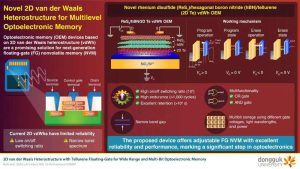From Dongguk University, Breakthrough in Memory Technology, Next-Gen Optoelectronic Memory with Tellurene
Novel optoelectronic memory device that addresses issues of conventional floating-gate NVM devices
This is a Press Release edited by StorageNewsletter.com on April 17, 2024 at 2:01 pmFrom Dongguk University
Despite rapid progress, conventional floating-gate nonvolatile memory devices still face critical challenges. Optoelectronic memory devices (OEMs) based on 2D van der Waal heterostructures (vdWhs) are a promising solution but suffer from reliability and endurance issues. Addressing these shortcomings, researchers have developed a novel rhenium selenide and 2D tellurene-based vdWh with multilevel storage capabilities, marking a significant step in OEM development.
The novel optoelectronic memory device exhibits impressive stability and a broad
adsorption spectrum, and is capable of multi-bit storage,
marking a significant step in floating-gate nonvolatile memory technology.
Click to enlarge
Floating-gate (FG) nonvolatile memory technology has witnessed rapid development in recent years, offering several advantages in areas like the IoT, multilevel storage, and next-gen flash memory. Despite this progress, critical challenges such as reducing memory cell size and power consumption are still not solved.
A promising solution to these challenges lies in optoelectronic memory (OEM) devices, which can convert light to electricity and vice versa, based on 2D van der Waal heterostructures (vdWhs). These heterostructures are composed of 2D material layers stacked in a precise order with weak inter-layer bonds, endowing them with unique optoelectrical properties. Previous studies have explored vdWh OEMs using different materials, including graphene, black phosphorous, and perovskite. However, these devices suffer from narrow light absorption spectrums, low on-off switching ratios, and low data retention, limiting their long-term use and reliability.
To address these problems, a team of researchers from Dongguk University, Korea, led by Professor Hyunsik Im, division of physics and semiconductor science, has developed a novel high-performance OEM based on rhenium disulfide (ReS2)/hexagonal boron nitride (hBN)/tellurene (2D Te) vdWh. Their findings were made available online on January 11, 2024, and published in Volume 18, Issue 05 of the journal ACS Nano on February 06, 2024.
The researchers fabricated the OEM device by stacking a few layers of ReS2 on top of a hBN layer followed by a 2D Te FG, all on a silicon dioxide substrate. Tests revealed that the ReS2/hBN/2D Te vdWh device exhibits exceptional long-term stability, a high on/off switching ratio of the order of 106, and impressive data retention, owing to the excellent optoelectrical properties of ReS2 and 2D Te. Moreover, it also demonstrated a broad absorption spectrum extending from the visible to near-infrared region at room temperature.
Expanding on the results, Prof. Im says: “Our device can achieve multi-bit storage states by varying the gate voltage, input laser wavelength and laser power, enabling complex data patterns and high data capacities. Furthermore, the device can perform fundamental OR and AND Boolean logic gate operations, crucial for digital circuits, by combining electrical and optical inputs. Our research marks a significant milestone in multi-bit optoelectronic memory technology, holding great potential in various applications, including artificial intelligence systems, cloud computing, and broadband optical programmability for digital circuits.”
Article: 2D van der Waals Heterostructure with Tellurene Floating-Gate for Wide Range and Multi-Bit Optoelectronic Memory
ACS Nano has published an article written by Thi Phuong Anh Bach, Sangeun Cho, Hyungsang Kim, Duc Anh Nguyen, and Hyunsik Im, division of physics and Semiconductor science, Dongguk University, Seoul 04620, Republic of Korea.
Abstract: “Intensive research on optoelectronic memory (OEM) devices based on two-dimensional (2D) van der Waals heterostructures (vdWhs) is being conducted due to their distinctive advantages for electrical–optical writing and multilevel storage. These features make OEM a promising candidate for the logic of reconfigurable operations. However, the realization of nonvolatile OEM with broadband absorption (from visible to infrared) and a high switching ratio remains challenging. Herein, we report a nonvolatile OEM based on a heterostructure consisting of rhenium disulfide (ReS2), hexagonal boron nitride (hBN) and tellurene (2D Te). The 2D Te-based floating-gate (FG) device exhibits excellent performance metrics, including a high switching on/off ratio (∼106), significant endurance (>1000 cycles) and impressive retention (>104 s). In addition, the narrow band gap of 2D Te endows the device with broadband optical programmability from the visible to near-infrared regions at room temperature. Moreover, by applying different gate voltages, light wavelengths, and laser powers, multiple bits can be successfully generated. Additionally, the device is specifically designed to enable reconfigurable inverter logic circuits (including AND and OR gates) through controlled electrical and optical inputs. These significant findings demonstrate that the 2D vdWhs with a 2D Te FG are a valuable approach in the development of high-performance OEM devices.“












 Subscribe to our free daily newsletter
Subscribe to our free daily newsletter
